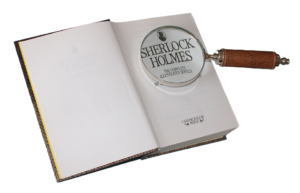
Updated November 15, 2019
Sir Arthur Conan Doyle’s iconic character Sherlock Holmes was a masterful investigator. You wouldn’t want anyone else on the case. He was a genius at putting together the puzzle pieces of a mystery to find the culprit of a crime. Holmes was nothing, however, if not a drug addict. Holmes’ drug of choice was cocaine, and as Doyle became more prolific, his character’s addiction only grew— this at a time when “opium dens” in the West were as ubiquitous as Starbucks.
Cocaine and Opium Dens in the Sherlock Holmes Series
The Starbucks analogy is apropos in a couple of ways: Opium dens in the nineteenth century were about as widely recognized around the world as the Starbucks franchise today; and, opium dens were places where patrons usually would buy their opium and then linger to enjoy it— like Starbucks patrons sipping on their coffees, only in this case patrons would be smoking opium.
Often run by and associated with Chinese immigrants, these places where opium was bought and smoked were very common throughout many parts of the world in the nineteenth century. At your average opium den, it would not be uncommon to see patrons reclining in order to maneuver and smoke from long pipes that were held over oil lamps.
The global prevalence of these establishments meant they enjoyed a good amount of cultural acceptance in nineteenth-century English society. Add to this cultural context the fact that Holmes was regularly injecting his drug of choice (cocaine) and it’s easy to see how Holmes would eventually end up in an opium den on an undercover assignment. In “The Man with the Twisted Lip,” Holmes is portrayed listlessly draped over an opium pipe, having had more than his fair share of the drug.
Other References to Drug Use in Sir Arthur Conan Doyle’s Stories
This image of Holmes strung out on opium is apparently not the only reference to drug use in Sir Arthur Conan Doyle’s stories, according to the literature scholar Sharon Ruston. She pointed out that “The Man with the Twisted Lip” describes two characters who, despite outwardly respectable lives, are regulars at East London opium dens. She also quoted Holmes (addressing Watson) as referring to his cocaine habit as one of those “little weaknesses on which you have favored me with your medical views.” For Ruston, these references to drug use in the Sherlock Holmes stories belong to a whole parade of representations of drugs in nineteenth-century literature.
Watson’s Disapproval 
Holmes wasn’t immune to the disapproval of his friends and loved ones. Watson can be found frequently deriding Holmes’ bad habit, but Watson also dismisses it as a distraction. You can almost hear Watson excusing it as a way for Holmes to quell his bored genius in-between cases. Further on in the series, however, Watson expresses his concern over Holmes’ growing addiction as a threat to Holmes’ thriving career.
The Evolution of Holme’s Drug Abuse Parallel to Public Perception
When Doyle started his beloved series, cocaine was becoming a sensation and was readily available and consumed often, especially by creatives. Opium was also being celebrated as a kind of miracle drug. By the time Doyle stopped writing the series, the health dangers of these substances had come into view. This may help to explain Watson’s shift in perspective later in the series, with respect to the seriousness of Holmes’ addiction.
Sir Arthur Conan Doyle’s Own Views on Cocaine, Opium and Drug Use
Interestingly, Sir Arthur Conan Doyle did not share his character’s preference for cocaine or opium, despite the enthusiasm of his lead character for these drugs. Doyle’s father reportedly suffered from a case of alcoholism that was so severe that it landed him in an insane asylum; this may help to explain why Doyle characterized alcohol’s effects as “unpleasant.”
Like his character Watson, Doyle was also a doctor and ophthalmologist-in-training and expressed similar skepticism about why anyone would be motivated to use cocaine. Whereas Doyle’s contemporary Sigmund Freud was quick to embrace cocaine and its euphoric qualities, Doyle himself was reportedly quoted as saying the following of the highly addictive stimulant: “Your brain may, as you say, be roused and excited, but it is a pathological and morbid process. Why should you, for a mere passing pleasure, risk the loss of those great powers with which you have been endowed? Remember that I speak not only as one comrade to another, but as a medical man.”
How Later Adaptations of Holmes Have Handled His Drug Habit
Since he first entered the literary world, Holmes has been the subject of many adaptations. The movie series starring Robert Downey Jr. is maybe the most well-known, recent film adaptation. (In this case, the choice of an actor with his own struggles with drug abuse may not have been coincidental, but also may be the reason that the movie version of Holmes does not dabble in drugs.) In the TV series Elementary, Holmes’ recovery from addiction and struggles with depression seem to feature more prominently than drugs or drug use. In the words of one New York Times reviewer, the Holmes who appears in Elementary is “a recovering drug user with daddy issues.” In contrast, the same reviewer wrote that the PBS version of Holmes seems to lack such weaknesses.
Don’t Wait to Get Help
If you resonate with Holmes’ weakness for cocaine, opiates or other drugs, please don’t wait until your bad habit has become a full-blown addiction. Get help now. At FHE we can help you recover from any drug or alcohol dependency, starting with a safe and comfortable detox. When you call us today at (833) 596-3502, we will be there to support you throughout your alcohol, amphetamine, or opiate withdrawal and recovery.






